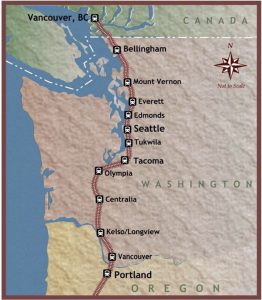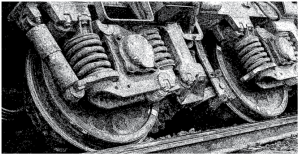Washington state has two potential tracks toward a 21st century rail future, with starkly different outcomes.
One provides higher speed, climate-friendly passenger service linking as many as 13 communities on the Cascadia corridor, with increased capacity for freight trains. It has been in development since 1991 and some elements have already been completed. It would provide clean, electrified Amtrak Cascades passenger service at up to 110mph along existing lines. The phased effort would rapidly create jobs, upgrade service and cut carbon pollution. It could be completed in a decade.

Tragically, this shovel-ready plan is being ignored while another flashy vision grabs the spotlight. That is the “ultra-high-speed rail” (UHSR) project proposed by Washington State Governor Jay Inslee’s administration and developed by WSP, a giant engineering firm. It offers a maximum of five stops along the route.
o facilitate speeds up to 220mph, it would require an entirely new passenger-only corridor acquired through costly land acquisitions and the controversial use of eminent domain, with many environmental challenges. While science tells us we need to dramatically cut carbon pollution this decade, UHSR would take many years before the first track is put on the ground and decades more to completion — if it happens at all.
The Washington State Long-Range Plan for Amtrak Cascades is a careful and detailed study done by the state beginning in 1991 and updated through 2006. Set out in six phases, the plan’s climate, service and job creation benefits would begin to be realized in the first few years. Thomas White, one of the authors of this essay, played a key role in the studies. Based on the plan, the current cost of upgrades would be $8.4 billion. While the plan did not include line electrification, we estimate that would add another $800 million for a total cost of $9.2 billion.
The UHSR line would cost an estimated at $24-$42 billion according to the 2019 study by WSP jointly supported by the state and Microsoft, Ultra-High-Speed Ground Transportation Business Case Analysis. The WSP study projects a 20-year path to completion. But the experience of California UHSR should give pause. An original estimate of $33 billion has ballooned to $80 billion and will likely rise higher. California began serious planning for its UHSR around 1990, around where Washington is today, and because of many delays will not complete its LA-Bay Area line until at least 2033, and probably later, a 40-year-plus stretch.
UHSR suffers from the law of diminishing returns. All those extra billions and decades would buy an hour or less in legs between major cities. The 110mph option would link Seattle to the other two cities in around 2–1/2 hours. The 220mph option would move from Seattle to Portland in 1–1/2 hours and to Vancouver in 1–3/4 hours. Though UHSR top speeds are double, they can only be achieved on part of the line. Annual ridership of around three million is projected for both, but the 110mph option would provide that at substantially lower costs and far sooner. Both offer downtown-to-downtown service and are highly competitive with air travel, which requires trips to airports and security checks. Arguably, because more stops would be served, the 110mph option would displace more highway traffic, by far the greater source of climate pollution.
Much of the additional cost and longer timeframe of UHSR come from the need to acquire and build an entirely new right of way with the straight lines and minimal curves required to run trains at up to 220mph. This entails many uncertainties, and as the California experience has demonstrated, substantial legal costs to defend eminent domain acquisitions from unwilling private landowners. Those alone would likely range in the billions. An additional complication would be the need to do extensive environmental review along the new right of way. Putting a new line through Western Washington landscapes would require extensive wetlands mitigation. Legal and environmental challenges would consume years before construction could begin.
An advantage of improving the existing rail corridor over building a new one is that freight can also run on these lines, whereas a UHSR line must be dedicated to the bullet train alone. Freight trains could generally run faster with better roadbeds and more sidings for slower trains. Rail is already at least three times more efficient than truck transportation, so taking freight from highways to rail is vital for reducing carbon pollution. Since trucks cause by far the most damage to highways, moving to rail also saves road maintenance dollars, not to mention improving air and water quality. Electrified freight would amplify the climate benefits, allowing use of low-carbon renewable energy.
Gov. Inslee has asked the Wa State Legislature for $3.25 million to begin planning UHSR implementation. Unfortunately, the governor and regional elites have been seduced by the glamorous bullet train vision. It is to be noted that one of Inslee’s advisors is a former WSP government affairs manager, which may have contributed to the advancement of this deeply flawed vision.
Because of the many difficulties and high costs that will almost certainly befall it, the UHSR project is destined to squander public enthusiasm for rail, instead of building confidence for rail as a climate solution. UHSR is already well on its way toward making rail another wedge issue to be framed as “by metropolitan elites, for metropolitan elites.”
This would be a tragic outcome, when rail-based solutions that utilize our most energy-and-cost-efficient form of ground transportation offer the opportunity to transcend partisanship and solve problems together. Improved freight service and more stops in smaller communities are attractive in ways that a bullet train serving primarily metropolitan passengers is not.
In any event, the region will need federal dollars to accomplish any vision for more rapid rail service. It is expected that rail funding will increase under Joe Biden, an ardent Amtrak supporter and user. Some might argue, why set one pathway against another? Can’t we both improve the Amtrak Cascades and move toward a dedicated UHSR line? If the UHSR vision were not sucking oxygen and focus from the Amtrak Cascades plan, they might have an argument.
But the facts are that regions across the country will line up for federal dollars. California’s HSR line is far short of the funding needed for completion, and it has a powerful congressional delegation and a vice president. The Washington state UHSR is nowhere near shovel-ready. In contrast, the Amtrak Cascades long-range plan provides multiple opportunities for funding, even in such a competitive environment. It already drew $800 million into the region under the 2009 stimulus.
The state and the region should set aside the bright shiny object that is UHSR for now, and prioritize a practical proposal to move forward with the Amtrak Cascades long-range plan. It will create jobs, provide improved service and reduce climate pollution far faster.
Thomas White is a veteran rail industry consultant. Bill Moyer is executive director of Backbone Campaign and co-author of Solutionary Rail. See Solutionary Rail and Climate Rail Alliance.
This article appeared in Medium and is reprinted here by permission of the author.

Be First to Comment